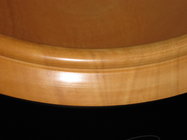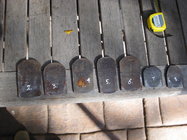Getting back to turning after a couple of years away
Not really interested in sanding or finishing bowls to gallery level anymore.
But I still enjoy turning bowls..
I am working develop technique to leave a minimum of tool marks and tearout.
I finish with beeswax or some other ez wipe finish.
I have a million tools like most turners.
Lately I've been using a bowl gouge, a scraper (1/2" and 3/4" thick) and a carbide (round bit) tool.
I was hoping this simple combination would get me where I want to be.
Initially I expected the gouge do most of the shaping, with the scraper and carbide tool to clean it up.
So far I've been surprised by the results
It seems the gouge does the best job of getting rid of tear out and tool marks.
I use a shear scrape (a la Bill Grumbine) and that seems to leave a better edge than either the scraper or the carbide tool.
However I can't make this shear cut over the entire exterior, or the interior.
Just wondering what workflow those trying to sand as little as possible (preferably note at all) use.
thanks,
Not really interested in sanding or finishing bowls to gallery level anymore.
But I still enjoy turning bowls..
I am working develop technique to leave a minimum of tool marks and tearout.
I finish with beeswax or some other ez wipe finish.
I have a million tools like most turners.
Lately I've been using a bowl gouge, a scraper (1/2" and 3/4" thick) and a carbide (round bit) tool.
I was hoping this simple combination would get me where I want to be.
Initially I expected the gouge do most of the shaping, with the scraper and carbide tool to clean it up.
So far I've been surprised by the results
It seems the gouge does the best job of getting rid of tear out and tool marks.
I use a shear scrape (a la Bill Grumbine) and that seems to leave a better edge than either the scraper or the carbide tool.
However I can't make this shear cut over the entire exterior, or the interior.
Just wondering what workflow those trying to sand as little as possible (preferably note at all) use.
thanks,


